Physical Address
304 North Cardinal St.
Dorchester Center, MA 02124
Uncommon; constitutes less than 10% of mediastinal cysts
May be congenital or acquired
Found in the anterior mediastinum but may occur in ectopic locations such as neck, pleura, and posterior mediastinum
Invariably benign
Age range: 20 to 50 years, often asymptomatic; larger cysts can present with cough, dyspnea, and chest pain
Acquired thymic cysts are associated with inflammatory processes and have been found in association with mediastinal Hodgkin lymphoma or its treatment, occasionally non-Hodgkin lymphoma, germinoma, yolk sac tumor, thymoma, thymic carcinoma, Langerhans cell granulomatosis, congenital syphilis, or prior thoracotomy for other diseases
Radiologic findings: well-circumscribed mass in the anterior mediastinum measuring up to 18 cm in diameter
Typically presents as a large encapsulated mass attached directly to thymic remnant or attached by a pedicle
Calcifications may be present in the cyst wall
Two types
Unilocular (congenital): thin-walled cyst filled with serous fluid
Multilocular (acquired): thick-walled cyst filled with thick, turbid hemorrhagic fluid
Unilocular cysts usually have a flat or cuboidal lining; thymic remnants are not usually appreciated in their walls ( Figure 5.1 )
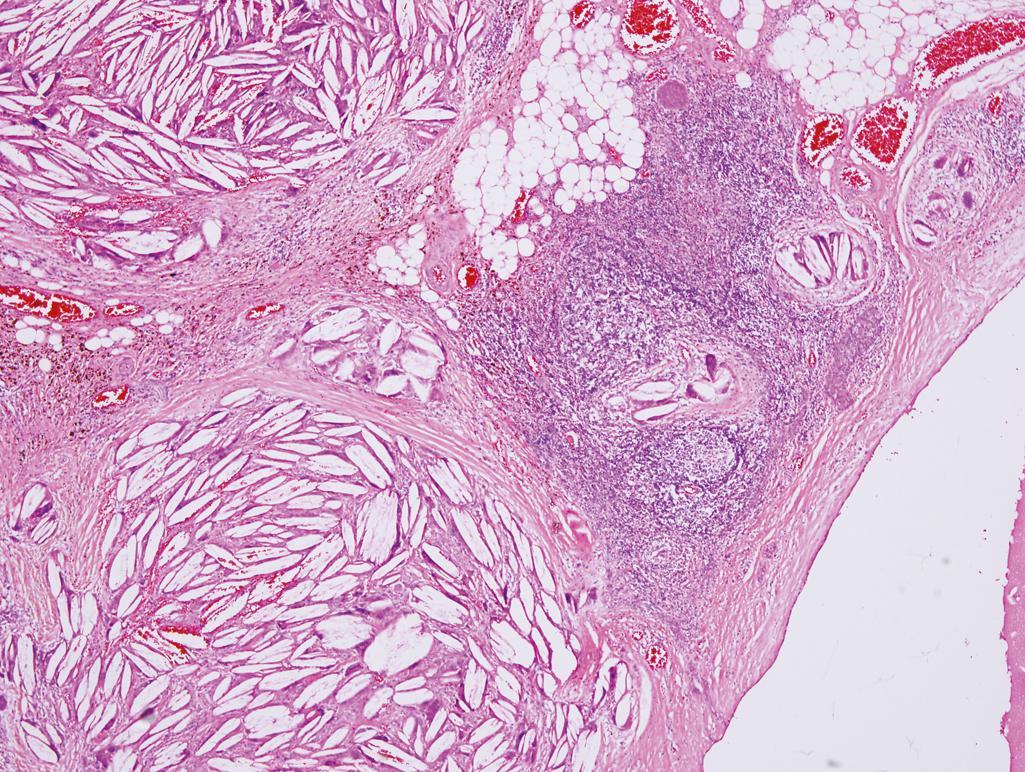
Multilocular cysts have a lining that is usually flattened but may be stratified squamous, cuboidal, columnar, or ciliated
The cyst lining is often in continuity with thymic remnants in the wall of the cyst and may be traced to dilated Hassall corpuscles
Inflammatory infiltrate is present in the walls of the cysts, often with hyperplastic follicles with prominent germinal centers
Cholesterol cleft granulomas are often present in the cyst wall
No cartilage, smooth muscle, or other differentiated mesenchymal tissue present within the cyst wall
Cytokeratin may highlight the epithelium and demonstrate thymic tissue in the wall
Noncontributory
Typically found in the anterosuperior mediastinum
Thin-walled cyst lined by attenuated parathyroid endocrine cells and filled with clear fluid
Most common in childhood
Composed of nonencapsulated complex cavernous spaces lined by flattened endothelium and filled with clear fluid and occasional small lymphocytes
Embedded in collagenous fibroblastic tissue with sparse lymphoid infiltrate
No epithelial elements present
Usually in continuity with the esophagus in the middle mediastinum
Cyst wall shows alternating layers of smooth muscle
No thymic tissue identifiable in the cyst wall
Usually few or no lymphocytes in the cyst wall
Attached to trachea or major bronchi
Lined by ciliated columnar (respiratory) epithelium but may occasionally undergo metaplastic changes
Smooth muscle and cartilage in cyst wall
No thymic tissue in wall
Cysts are lined by any type of epithelium and may contain sebaceous glands and hair follicles
Other common components include neural tissue, gastrointestinal tract elements, cartilage, and respiratory structures
Monodermal teratoma may show only epithelial elements and a prominent granulomatous foreign body–type response
May present as a discrete area of thickening or nodularity in the wall of a multilocular cyst
Expansile nodule showing biphasic population of small T lymphocytes and thymic epithelial cells devoid of normal thymic architecture
Represents cystic degeneration of thymic tissue within or adjacent to the tumor
Solid foci showing a mixed population of lymphocytes with atypical lymphoid cells
Demonstration of Reed-Sternberg cells by immunohistochemical staining with appropriate markers (e.g., Ber-H2, CD30)
The foregut cysts of the mediastinum are believed to represent congenital developmental anomalies
a Cystic neoplasms are discussed with the corresponding tumor types.
Bronchial and esophageal cysts may be asymptomatic or present with cough, dyspnea, pain, or dysphagia due to compression
Usually found in adults
Moves with respiration
Presents in childhood or adolescence
Male predominance
Also known as foregut duplication cyst or enterogenous cyst
Usually presents in infancy or childhood
Strong male predominance
Patients may have cough, pain, dysphagia, dyspnea, failure to thrive; rarely presents with massive hemoptysis
May be associated with other congenital malformations, including vertebral abnormalities, intestinal atresia or malrotation, and congenital cardiac malformations
Round and usually unilocular
Size varies from a few millimeters up to 15 cm
Attached to trachea or major bronchus
Mucinous contents
Typically located at the level of the midesophagus; may be attached to or within the wall of esophagus
Mucinous contents
Mostly confined to the posterior mediastinum
Predilection for children and adolescents
Usually attached to the vertebral column
Thin wall
May present with dysphagia if there is compression of the esophagus
Epithelium is typically respiratory columnar but may undergo squamous metaplasia ( Figure 5.2 )
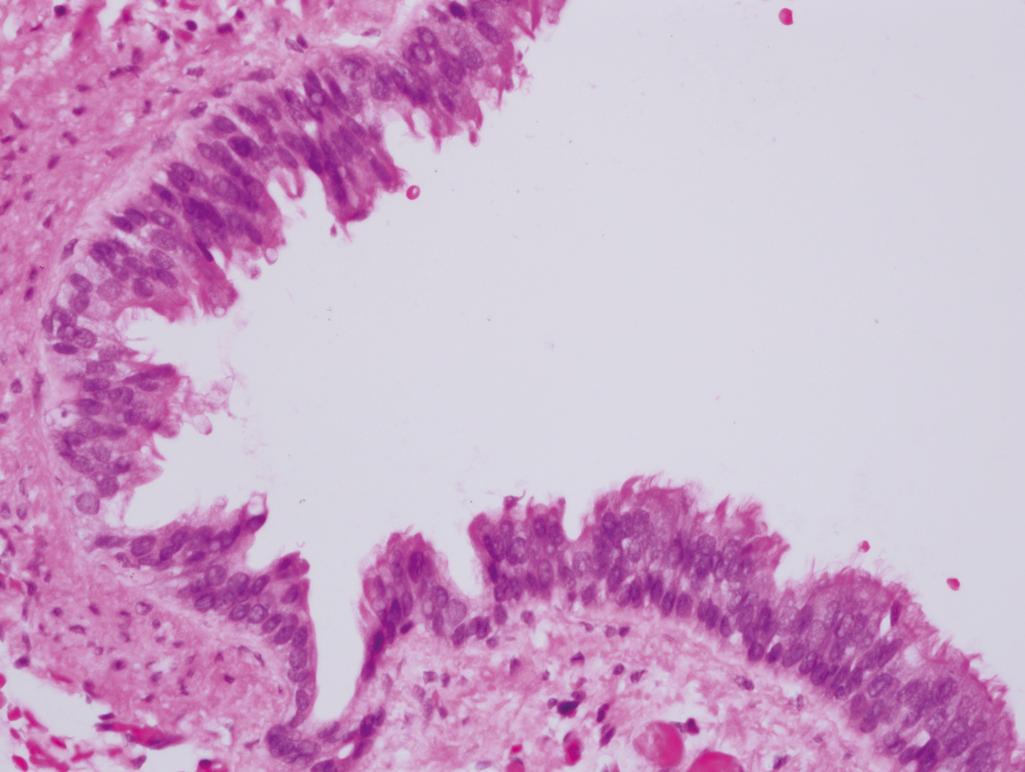
Cartilage and smooth muscle are present in the cyst wall
Epithelium is typically squamous but may be columnar
Two discrete layers of smooth muscle are present at least focally in the cyst wall
No cartilage
Epithelium may be of gastric type (including parietal cells), intestinal, colonic, or squamous
Cyst lining has a lamina propria, muscularis mucosa, and muscularis propria
Cyst wall may contain ganglion cells
Particularly in cysts with gastric mucosa, ulceration and hemorrhage may be present because of the effects of acid production
Noncontributory
Noncontributory
Lining epithelium is usually squamous
Lymphocytes and true thymic tissue in the wall
No well-defined smooth muscle layers
No cartilage
Distinctive mesothelial lining
Filled with clear thin fluid
Lacks well-developed muscle bundles and lamina propria
Generally located in the anterior mediastinum
Typically has focal solid areas
Additional tissue types foreign to the site of origin are common and often consist of neural elements, cartilage, and pancreatic islets
Not attached to bronchus, esophagus, or vertebral column
Some cysts show overlap features between different types of cysts in this section; these represent partial duplication of structures derived from the foregut but cannot be subclassified into one of the three types described here and are generically termed foregut cysts
Computed tomography (CT) and magnetic resonance imaging can define the anatomic relationships and the cystic nature of the lesion
Surgical resection is curative
Typically found at the costophrenic angle; may occur in the mediastinum
Affects men and women of all ages; more common in adults than children
When attached to pericardium, is designated as a pericardial cyst
Thin-walled cyst filled with clear serous fluid
Typically unilocular
Pericardial cysts may have mucoid contents
Typically has an attenuated mesothelial lining with fibrous tissue within the cyst wall
Lacks smooth muscle, specialized epithelium, and cholesterol granulomas
Noncontributory
Noncontributory
Located in the anterior mediastinum; more superior than pericardial and mesothelial cysts
Residual thymic tissue is found in the wall on careful examination
Epithelium is sometimes hyperplastic
Typically found in anterior mediastinum
More common in childhood
Usually multiloculated with fibrous walls lined by attenuated cells
Cyst lining cells are cytokeratin negative but may express one or more antigens of endothelial cells (CD31 or CD34)
Mesothelial cysts are most often asymptomatic and found incidentally upon radiologic examination
Differentiation between mesothelial and pericardial cysts is based on anatomic location
Cysts attached to the pericardium are pericardial cysts
Mesothelium-lined cysts elsewhere in the mediastinum are mesothelial cysts
Careful gross and histologic examination may be necessary to exclude thymic tissue or elements of a foregut cyst
Mesothelial cysts are always benign
Drainage under radiologic guidance may be an alternative to surgical resection
Seen in children and occasionally in adults after chemotherapy for malignancy
May be associated with hyperthyroidism, myasthenia gravis, or another autoimmune disease
Thymic enlargement with increase in volume and normal weight of the gland
Normal lobular architecture with normal distribution of lymphocytes and epithelial cells
Preservation of corticomedullary differentiation
Noncontributory
Noncontributory
Differentiation into cortex and medulla is usually absent
If areas resembling cortex and medulla are present, they are not arranged normally and do not display the normal lobulation
Well-formed lymphoid follicles with germinal centers
CD20-positive B lymphocytes are present within germinal centers
Tables of normal thymic weights are derived from autopsy data; most of the specimens were therefore obtained from ill patients; data on normal thymic weights in previously healthy persons, especially infants and children, are relatively scant
Thymic hyperplasia after chemotherapy, especially when given for Hodgkin disease, may mimic recurrent tumor radiologically
Associated with myasthenia gravis, rheumatoid arthritis, systemic lupus erythematosus, and other autoimmune disorders
Thymus is of normal size and weight in most cases
Thymic hyperplasia is characterized by numerous follicles with germinal centers
Follicles are composed of normal B-cells and will show reactivity with CD20
Flow cytometry or molecular diagnostic techniques—that is, gene rearrangement—can rule out clonality if lymphoma is in the differential
Patients usually have widespread systemic disease
Uncommon in young adults
More uniform population of lymphoid cells
Few or no tingible body macrophages
Flow cytometry and molecular diagnostic techniques demonstrate a monoclonal population of B-cells
B-cells in follicles strongly express bcl-2 protein
Normal thymic lobules show sharp angles; follicles are round
Hassall corpuscles are seen in the thymic medulla, not in germinal centers
Thymic medulla contains cytokeratin-positive epithelial cells, which are not seen in germinal centers
The thymic gland is usually of normal size and weight
Follicular lymphoid hyperplasia is usually present in nonneoplastic thymic tissue of patients with myasthenia gravis
About 10% of patients with myasthenia gravis have thymoma
About 25% to 50% of patients with thymoma have myasthenia gravis
About 25% of patients with myasthenia gravis have normal thymic histology
Rare tumor
Peak incidence in young adults
Often large; patients are symptomatic (dyspnea, cough) as a result of compression of adjacent structures
Thymus gland is enlarged but soft, with preserved lobulation
Yellow cut surface with whitish fibrous strands
Mature adipose tissue interspersed with strands of unremarkable thymic tissue
Thymic component may be well populated with lymphocytes
Noncontributory
Noncontributory
Involuted thymus is normal in size or smaller than normal for age
Contains little or no fat
Occurs mostly in middle-aged to older adults
Occurs anywhere in the mediastinum but rarely within the thymus
Does not contain thymic tissue
Appearance on CT may suggest a cyst
Probably a hamartoma
Rare associations include Graves disease, Hodgkin lymphoma, and myasthenia gravis
Most commonly found in adults; peak incidence is in the fifth decade
Most common solid primary neoplasm of the mediastinum
Typically located in anterosuperior mediastinum; may also arise from thymic rests: pleura, pulmonary hilum, pericardium, posterior or middle mediastinum and thyroid
Radiograph shows a lobulated mass that is occasionally calcified
Clinical associations
Myasthenia gravis
Lambert-Eaton syndrome
Pure red cell aplasia
Hypogammaglobulinemia
Other associations
Systemic lupus erythematosus
Rheumatoid arthritis
Scleroderma
Polymyositis
Prognosis and staging: thymomas exhibit a range of biologic behavior from noninvasive encapsulated tumors to aggressive infiltrative tumors
Most noninvasive tumors are cured by surgical resection
The most important predictor of clinical course is the presence and extent of invasion into other mediastinal structures
The staging system used for thymomas reflects this range of behavior (Modified Masaoka staging)
Stage I: completely encapsulated (including microscopic invasion into the capsule)
Stage IIa: microscopic invasion through the capsule
Stage IIb: macroscopic invasion into surrounding fatty tissue or pleura/pericardium
Stage III: macroscopic invasion of neighboring organs (pericardium, great vessels, or lung)
Stage IVa: pericardial or pleural implants
Stage IVb: Hematogenous or lymphatic dissemination
Most are lobulated and encapsulated with a solid gray-white cut surface
Larger tumors may show extensive cystic changes
Thymomas exhibit a range of histologic features
Generally encapsulated with a distinct fibrous capsule
Dual cell population composed of neoplastic proliferation of thymic epithelial cells admixed with variable numbers of nonneoplastic T lymphocytes
Most T lymphocytes are of the cortical type (immature)
Most thymomas display organotypic morphology, meaning that the tumors show features distinctive of the normal thymus, including
Fibrous bands forming angulated tumor lobules
Variable numbers of immature T lymphocytes
Proliferation of bland-appearing thymic epithelial cells
Dilated perivascular spaces
Foci of so-called medullary differentiation (rounded areas with lower lymphocyte density)
No significant cytologic atypia or pleomorphism
Neoplastic epithelial cells may be of two types
Oval or spindle cells with bland nuclei and dispersed chromatin with occasional small chromocenters
Round or polygonal (epithelioid) cells with abundant lightly eosinophilic or amphophilic cytoplasm and distinct round eosinophilic nucleolus
The histologic classification is still a matter of debate; the most commonly accepted scheme is the one proposed by the World Health Organization (WHO; Travis et al., 2015)
WHO thymoma type A: composed primarily of benign-appearing spindle cells ( Figure 5.3 )
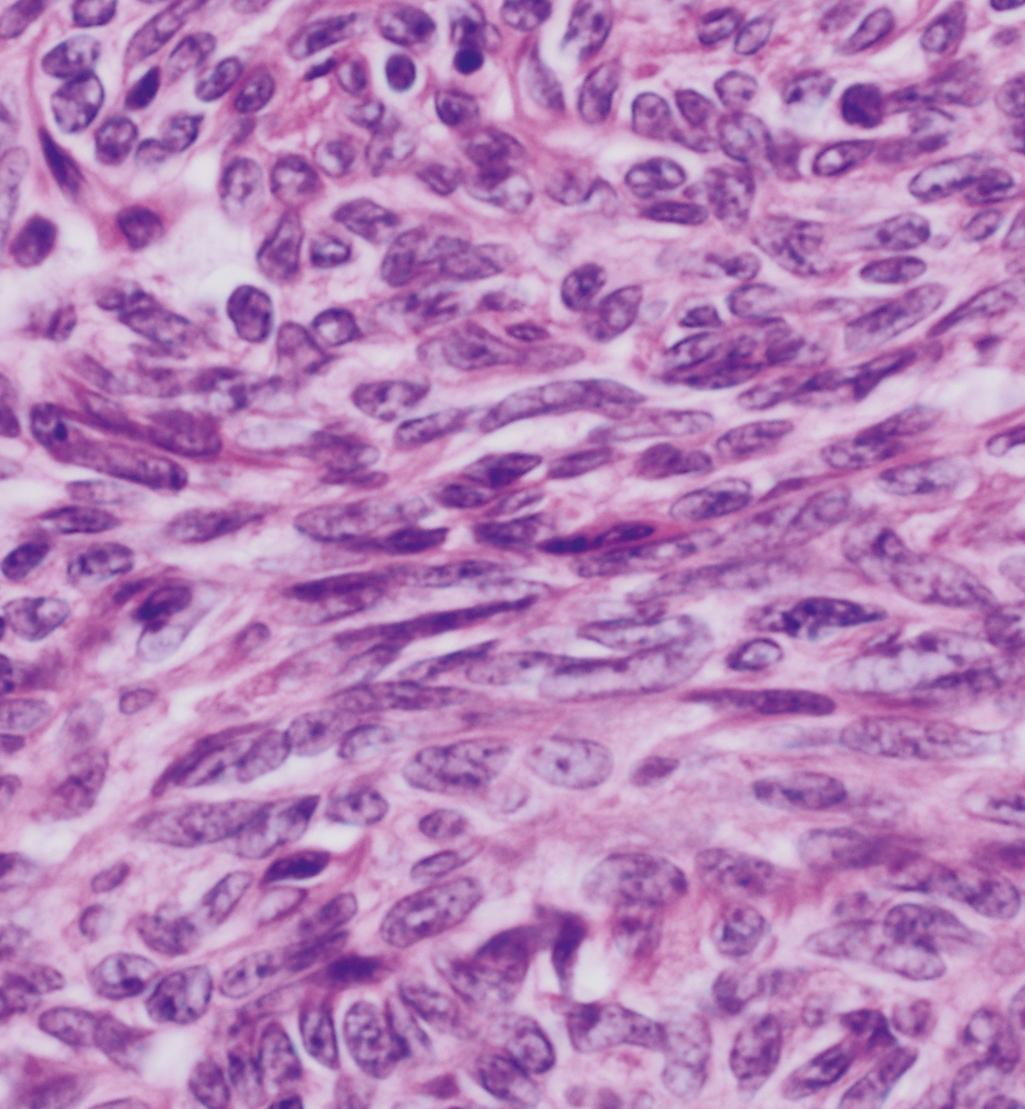
WHO thymoma type AB: composed of small spindle cells (type A) admixed with abundant lymphocytes
WHO thymoma type B: composed of round or polygonal epithelial cells with varying amounts of immature and mature T lymphocytes ( Figure 5.4 ); this group is subdivided into three types (B1–B3) based on a progressive decrease in the proportion of lymphocytes to epithelial cells and a progressive increase in cytologic atypia of neoplastic epithelial cells
Type B1: large number of T lymphocytes containing few, isolated, scattered round or polygonal thymic epithelial cells with minimal cytologic atypia ( Figure 5.5 )

Type B2: about equal number of T lymphocytes and thymic epithelial cells showing mild to minimal cytologic atypia
Type B3: large number of polygonal epithelial cells admixed with few lymphocytes; the epithelial cells show enlarged nuclei with an increased chromatin pattern, occasional prominent nucleoli, and rare mitotic figures; they contain abundant eosinophilic cytoplasm with sharp cell borders ( Figure 5.6 )
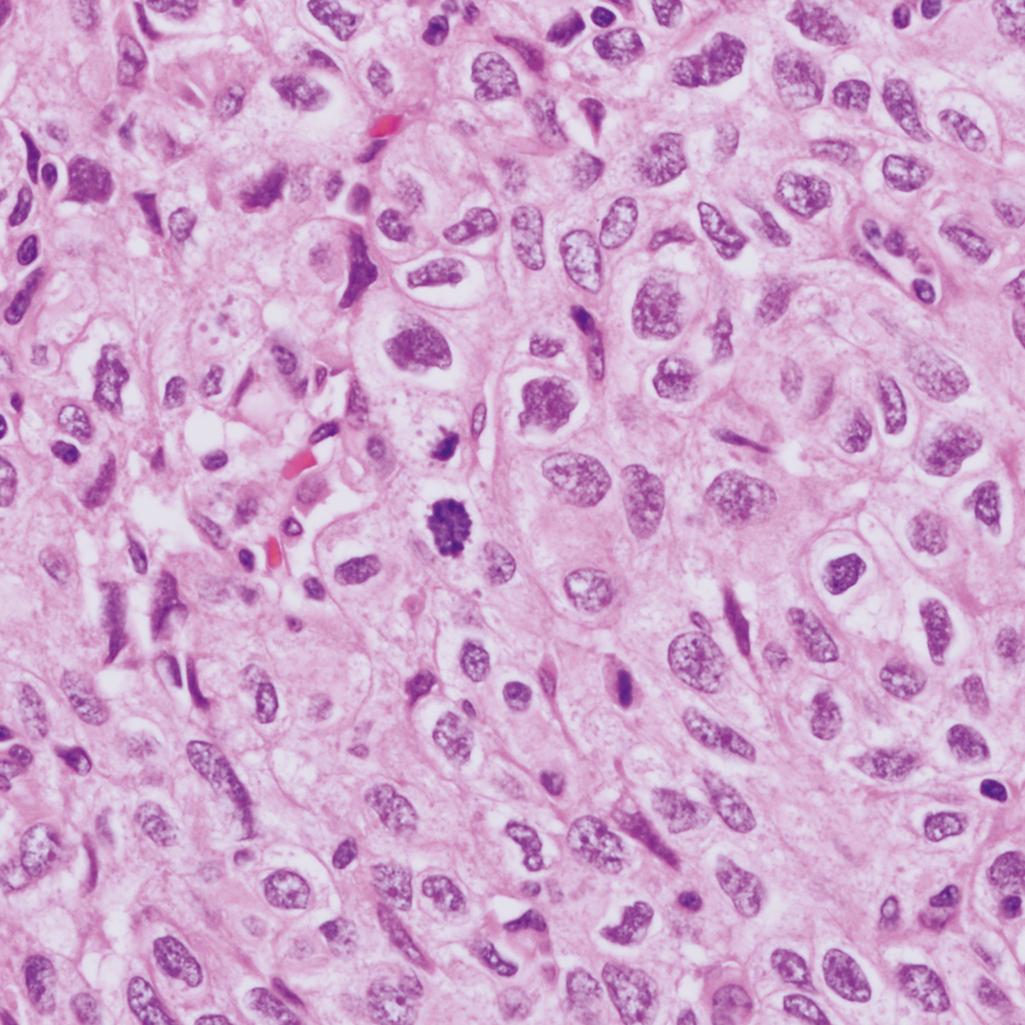
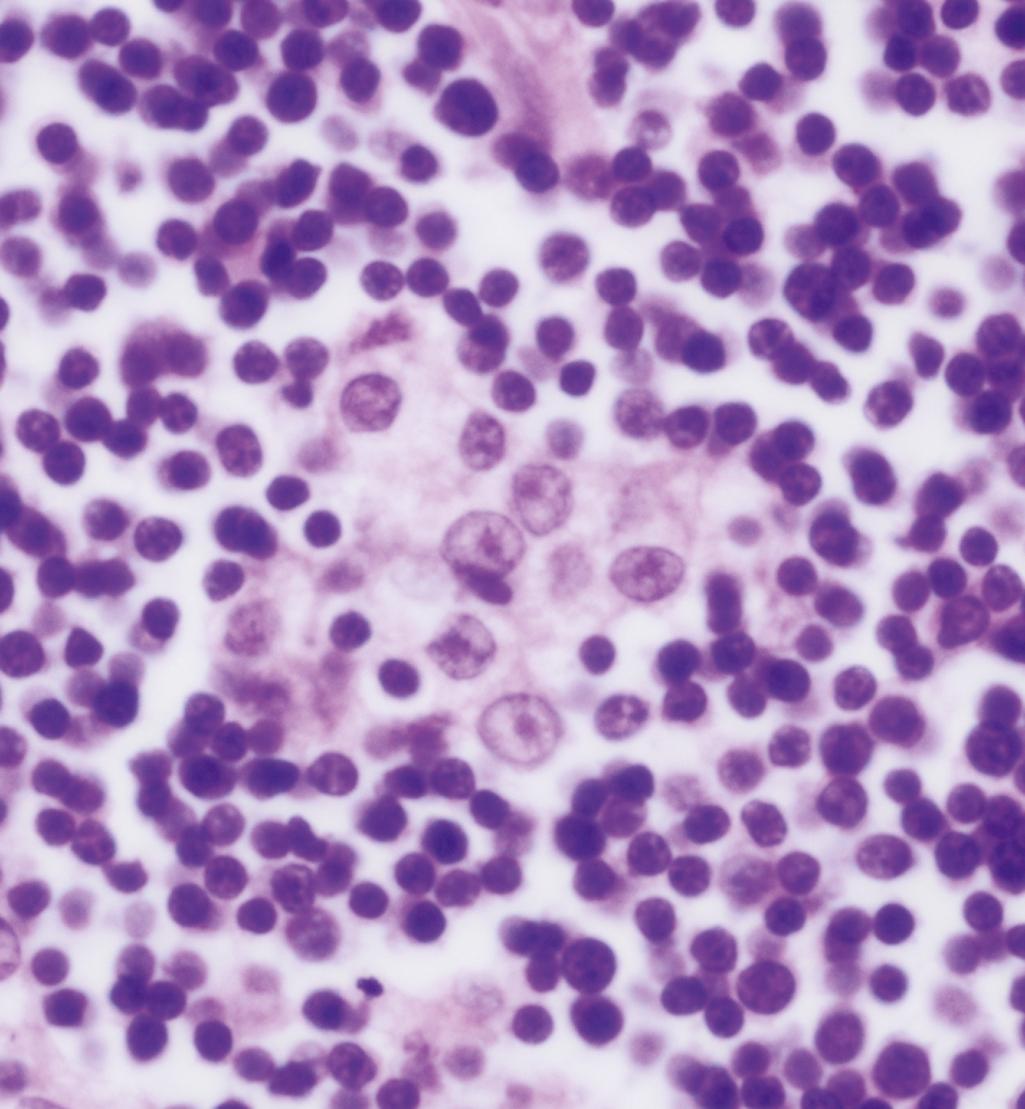
WHO thymomas of special types, including micronodular thymoma, metaplastic thymoma, microscopic thymoma, thymoma with anaplasia, and thymic carcinoma
Limitations of this scheme include difficulties in interobserver reproducibility, overlap in cytologic features for the various categories due to tumor heterogeneity, conflicting results of clinical survival studies for the various categories, lack of a biologic substrate for the classification, and the existence of numerous morphologic variants that do not fit into any of the standard categories
Unusual morphologic variants include thymomas with clear cells, glandlike structures, cribriform areas, macrocystic and microcystic structures, papillary structures, rhabdomyomatous cells, heavy plasma cell stromal infiltration, extensive areas of infarction and necrosis, starry-sky pattern, storiform pattern (in spindle cell thymoma), hemangiopericytic pattern (in spindle cell thymoma), rosette-like structures (in spindle cell thymoma), spindle cell pseudosarcomatous stroma, massive stromal sclerosis, and others
Classification of thymomas
There has been considerable controversy in recent years regarding which (if any) of these histologic features predict clinical behavior or reflect the differentiation of the tumor cells
Table 5.1 shows the numerous classification schemes for thymoma
| World Health Organization (Travis, 2004) | Traditional (Bernatz et al., 1961) | Histogenetic (Marino and Müller-Hermelink, 1969) | Suster and Moran (1999) |
|---|---|---|---|
| Type A | Spindle cell thymoma | Medullary thymoma | Thymoma, well differentiated |
| Type AB | — | Mixed thymoma | Thymoma, well differentiated |
| Type B1 | Lymphocyte-rich thymoma | Cortical thymoma | Thymoma, well differentiated |
| Type B2 | Lymphoepithelial thymoma | Predominantly cortical | Thymoma, well differentiated |
| Type B3 | Epithelium-rich thymoma | Well-differentiated thymic carcinoma | Atypical thymoma (moderately differentiated) |
| Thymic carcinoma (formerly thymoma type C) | Thymic carcinoma | Thymic carcinoma | Thymic carcinoma (poorly differentiated thymic epithelial neoplasm) |
Features used for classification
Type of epithelial cell (spindle versus round or polygonal)
Organotypic organization
Relative proportion of epithelial cells and lymphocytes
Degree of epithelial atypia
Features predictive of invasion or metastatic potential include:
Predominance of polygonal epithelial cells
Epithelial pleomorphism and atypia
Loss of organotypic features
Thymic tumors with overtly malignant epithelium are called thymic carcinomas (see under “Thymic Carcinoma”)
Have limited role in diagnosis
Cytokeratin: highlights epithelial cells, particularly in lymphocyte-rich tumors
P63 and PAX8: nuclear positivity in thymic epithelial cells
CD3: highlights T-cell population
CD1a/CD99: highlight immature T lymphocytes
CD20: may be positive in epithelial cells of some thymomas
Electron microscopy: very limited role; can demonstrate tonofilaments, tight intercellular junctions, desmosomes, elongated cytoplasmic processes, and basal lamina of epithelial cells; high potential for sampling error
Flow cytometry: can be misleading in cases of lymphocyte-rich thymoma by showing an immature terminal deoxynucleotidyl transferase (TdT)–positive lymphoblastic population, which can lead to an erroneous diagnosis of lymphoblastic lymphoma
Gene rearrangement studies: no clonality is found in the lymphocytes of thymoma
Molecular genetic testing: approximately 80% of type A and type AB thymomas harbor GTF2I somatic point mutations
Thymic tissue maintains normal thymic architecture in hyperplasia; architecture and cortical or medullary proportions are distorted in thymoma
Cases with lymphoid follicular hyperplasia contain follicles with active germinal centers
The most likely lymphoid neoplasms to be confused for thymoma are lymphoblastic, Burkitt, and Hodgkin lymphoma
Most often seen in children and adolescents
Patients often have leukemia, with blasts in peripheral blood
Medium-sized lymphoid cells with fine chromatin and absence of nucleoli; mitoses are typically numerous
Most often of T-cell lineage; expresses TdT and other early T-cell antigens
May reflect the pattern of antigen expression seen on normal and mature cortical or medullary thymocytes; therefore flow cytometry must be interpreted with caution
Molecular diagnostics (gene rearrangement studies) may be needed to rule out a clonal T-cell process
The most important stain for diagnosis is cytokeratin, which shows scattered keratin-positive thymic epithelial cells admixed with the immature lymphoid cell population in lymphocyte-rich thymoma
Clonal B-cell process that can be demonstrated by flow cytometry
Sheets of primitive lymphoid cells with multiple small nucleoli
Can be confused with lymphocyte-rich thymoma owing to starry-sky pattern
Cytokeratin demonstrates no epithelial cell component
Ki-67 shows virtually 100% positivity of the lymphoid cells
Reed-Sternberg and lacunar cells may be identified immunohistochemically (positive for CD15 and CD30, negative for CD3, CD45, and CD20), whereas the atypical epithelial cells of thymoma demonstrate cytokeratin staining
Hodgkin lymphoma is often associated with cystic changes of the thymus
Characteristic follicles with hyalinized vessels and sclerotic germinal centers surrounded by concentrically arranged layers of lymphocytes in the mantle zone (“onion skinning”)
Both can show a storiform pattern
Spindle cells in spindle cell sarcomas are reactive for vimentin and negative for cytokeratin
Spindle cell thymoma can resemble solitary fibrous tumors due to a prominent hemangiopericytic growth pattern; cells are positive for cytokeratin in thymoma
Thymomas are tumors of the epithelial component of the thymus; associated lymphocytes in the background are benign
Thymomas have a strong association with myasthenia gravis and other autoimmune disorders
The primary treatment is surgical excision
Classification is still controversial
Invasion of adjacent mediastinal structures remains the most widely accepted predictor of aggressive behavior
Thymic epithelial neoplasm with cellular atypia and a generally aggressive clinical course
No association with paraneoplastic syndromes of thymoma, such as myasthenia gravis or pure red cell aplasia
May arise from malignant progression in a long-standing preexisting thymoma
Predominantly found in middle age to late adulthood
Patients may present with chest pain, dyspnea, or superior vena cava syndrome
Primary thymic carcinomas are rare; secondary invasion of the thymus by primary carcinoma of the lung or metastatic tumor in mediastinal lymph nodes is more common
Thymic carcinoma is a diagnosis of exclusion; extensive clinical and radiologic studies must be undertaken to rule out the possibility of an occult or late metastasis from another organ before rendering this diagnosis
Usually not encapsulated
Gray-white tumor with a hard, gritty cut surface often showing hemorrhage and necrosis
Stroma may be desmoplastic, but these tumors do not have the broad fibrous septa seen in thymoma
Some variants may have prominent cystic changes
Become a Clinical Tree membership for Full access and enjoy Unlimited articles
If you are a member. Log in here